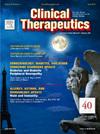曲妥珠单抗德鲁西替康和曲妥珠单抗Govitecan治疗激素受体阳性和人表皮生长因子受体2-低转移性乳腺癌:成本-效果分析
IF 3.6
4区 医学
Q2 PHARMACOLOGY & PHARMACY
引用次数: 0
摘要
目的:分析曲妥珠单抗德鲁德替康(T-DXd)和舒妥珠单抗戈维坦(SG)治疗曾接受化疗的激素受体阳性(HR+)和人表皮生长因子受体2-低(her2 -低)转移性乳腺癌患者的药物经济学特征。方法:从美国支付方的角度对这两种治疗方案分别与化疗进行成本-效果研究,比较其经济影响和临床结果。对接受曲妥珠单抗德鲁西替康或舒妥珠单抗戈维坦治疗的患者(分别为T-DXd组或SG组),采用了一个包含三种不同状态的分区生存模型进行模拟。相关的健康偏好信息和成本数据收集自已发表的文章。结果:与化疗相比,T-DXd组提供了额外的0.34816质量调整生命年(QALYs)。这一收益与222,149美元的增量成本相关,导致每个QALY的增量成本效益比(ICER)为638.066美元。与化疗相比,SG组的QALYs增加了0.17469个。这一收益伴随着221,830美元的增量成本,导致每个QALY的ICER为1,269,849美元。T-DXd和SG的ICERs都超过了每个QALY 150,000美元的预定支付意愿(WTP)门槛。单变量敏感性分析显示,SG和T-DXd的成本对结果有一定的影响,而其他变量的影响最小。结论:从美国付款人的角度来看,在每个QALY的支付意愿(WTP)阈值为150,000美元时,与先前接受过化疗的HR+和her2低转移性乳腺癌患者相比,T-DXd和SG不太可能具有成本效益。然而,相对于SG, T-DXd在没有显著增加成本的情况下实现了更高的QALYs。本文章由计算机程序翻译,如有差异,请以英文原文为准。
Trastuzumab Deruxtecan and Sacituzumab Govitecan for Hormone Receptor-Positive and Human Epidermal Growth Factor Receptor 2-Low Metastatic Breast Cancer: A Cost-Effectiveness Analysis
Objective
We aim to analyze the pharmacoeconomic characteristics of trastuzumab deruxtecan (T-DXd) and sacituzumab govitecan (SG) in the treatment of patients with hormone receptor-positive (HR+) and human epidermal growth factor receptor 2-low (HER2-low) metastatic breast cancer who have previously undergone chemotherapy.
Methods
A cost-effectiveness study was conducted to compare these two treatment options with chemotherapy, respectively, in terms of their economic impact and clinical outcomes from the perspective of the United States payer. A partitioned survival model with a lifetime horizon comprising three distinct states was utilized for the simulation process of patients receiving trastuzumab deruxtecan or sacituzumab govitecan (in the T-DXd or SG group, respectively). The relevant health preference information and cost data were gathered from published articles.
Results
The T-DXd group, when compared to chemotherapy, provided an additional 0.34816 quality-adjusted life years (QALYs). This benefit was associated with an incremental cost of $222,149, resulting in an incremental cost-effectiveness ratio (ICER) of $638.066 per QALY. For the SG group, in comparison to chemotherapy, an extra 0.17469 QALYs were yielded. This gain was accompanied by an incremental cost of $221,830, leading to an ICER of $1,269,849 per QALY. The ICERs for both T-DXd and SG surpass the predetermined willingness-to-pay (WTP) threshold of $150,000 per QALY. The univariate sensitivity analysis revealed that the costs of SG and T-DXd had a certain influence on the results, whereas other variables had minimal impact.
Conclusion
From the perspective of a U.S. payer, at a willingness-to-pay (WTP) threshold of $150,000 per QALY, both T-DXd and SG were unlikely to be cost-effective compared to chemotherapy for HR+ and HER2-low metastatic breast cancer patients who have previously undergone chemotherapy. However, relative to SG, T-DXd achieved greater QALYs without a significant increase in cost.
求助全文
通过发布文献求助,成功后即可免费获取论文全文。
去求助
来源期刊

Clinical therapeutics
医学-药学
CiteScore
6.00
自引率
3.10%
发文量
154
审稿时长
9 weeks
期刊介绍:
Clinical Therapeutics provides peer-reviewed, rapid publication of recent developments in drug and other therapies as well as in diagnostics, pharmacoeconomics, health policy, treatment outcomes, and innovations in drug and biologics research. In addition Clinical Therapeutics features updates on specific topics collated by expert Topic Editors. Clinical Therapeutics is read by a large international audience of scientists and clinicians in a variety of research, academic, and clinical practice settings. Articles are indexed by all major biomedical abstracting databases.
 求助内容:
求助内容: 应助结果提醒方式:
应助结果提醒方式:


